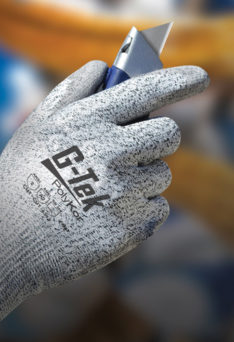Better understanding of glove coatings
How critical is a glove’s coating when selecting cut-resistant hand protection?

Responding is Joe Milot Jr., senior product manager, hand protection, Protective Industrial Products Inc., Latham, NY.
Employers and safety directors are taking action to develop programs and provide personal protective equipment that can help reduce and/or avoid injuries to their employees. And understandably so: The costs and impact of injuries can be significant to any organization.
One of the growing trends in PPE has been the migration from general purpose and commodity gloves (such as standard leather gloves) to cut-resistant gloves. When we consider the following statistics from the Bureau of Labor Statistics, it’s easy to see why: Over 1 million workers are sent to the emergency room each year as a result of hand injuries. Of those, 70 percent who experience hand injuries are not wearing gloves at the time the injury occurred, and the other 30 percent are wearing inappropriate or inadequate hand protection.
To address these issues, cut scores and comfort have been among the strongest considerations that employers and safety directors use to evaluate hand protection solutions. However, a third, equally critical component should not be overlooked: the glove’s coating.
Cut injuries usually occur when a sharp or rough object moves or slips within a person’s hand. It’s generally not because of a downward force on the hand. A stronger, more secure grip helps prevent the tendency of an object to slip, and the glove’s coating determines the grip.
Unfortunately, there isn’t a “one solution for everyone” approach to selecting the best coating for a given work environment. As the object being handled becomes wetter or more oily, the propensity for the object to slip also increases. And whether the work conditions are dry, wet or oily – and to what degree – impacts a coating’s performance differently. This variation is the reason why the glove’s coating is so critical to the selection process.
A quick review of the hand protection market shows several coating options available to choose from. The most common options fall into one of the following categories: nitrile, polyurethane or latex.
To help increase friction and enhance the grip characteristics of the coating, a microsurface, crinkle or foam option should be evaluated. All other variables being equal, rougher surfaces don’t tend to slip as easily as smoother surfaces. The same practice applies to coatings, which is why these variations are available for consideration.
“Critical,” “variations” and “options” do not have to mean “confusing.” A simple assessment of the work environment will help identify the potential hazards of each task. Knowing and understanding the needs of the worker based on the application helps to simplify the process and eliminate several options from consideration.
When selecting hand protection solutions, remember the three C’s: cut score, comfort and coating.
Post a comment to this article
Safety+Health welcomes comments that promote respectful dialogue. Please stay on topic. Comments that contain personal attacks, profanity or abusive language – or those aggressively promoting products or services – will be removed. We reserve the right to determine which comments violate our comment policy. (Anonymous comments are welcome; merely skip the “name” field in the comment box. An email address is required but will not be included with your comment.)

